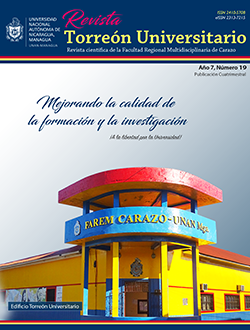The cognitive sciences: preamble to understand the operation of the schemes of the human being
DOI:
https://doi.org/10.5377/torreon.v7i19.7908Keywords:
cognitive sciences, autopoiesis, cerebral plasticity, mirror neurons, memory, nervous hologramAbstract
Several generations of cognitive science studies have resulted in a wide variety of theories. In these, different aspects of the system that allow the human being to function in different environments are addressed. This is possible, because the brain system is plastic (adaptable), restructures itself on a scale of reality, imperceptible to the human senses. Along with this quality, there are others that encode information. That is the case of the mirror neuronal system that encodes the intentions of others, which allows us to understand each other. Learning schemes can be structured, considering the holographic model of the mind, which exposes the way in which consciousness is distributed throughout the brain system and functions as a mechanism for information retrieval from different areas. These systems have as a product what in neuroscience is called memory, which is individual and collective. Finally, language supports these mental capacities and allows the communicative manifestation of the schemes, through interaction with others.
Downloads
Downloads
Published
How to Cite
Issue
Section
License
The authors who publish in this journal agree to the following terms.
- The author or authors of the articles, essays or research grant the National Autonomous University of Nicaragua, Managua (UNAN-Managua) the editing rights (copyright) of the submitted work, therefore the University has the exclusive right to publish the article for the entire copyright period.
- These copyrights/authors authorize Torreón Universitario Magazine and the University to edit and disseminate/publish the article in said Magazine, including printed and electronic reproduction, storage, retrieval and any other type of publication, and sources of secondary information as services. of summaries and databases, they also empower it to protect the article against unauthorized use for dissemination by printed or electronic media (PDF, HTML, EPUB, XML or others).
License for use of content
The magazine uses the Creative Commons Attribution-NonCommercial-NoDerivs 4.0 International License.
Under this statement:

This journal is licensed under a Creative Commons Attribution-NonCommercial-NoDerivatives 4.0 International License. It can be copied, distributed and transmitted publicly as long as the author and source are cited (Revista Torreón Universitario), it should not be modified or used for any commercial purpose. The full license can be found at http://creativecommons.org/licenses/by-nc-nd/4.0/.



